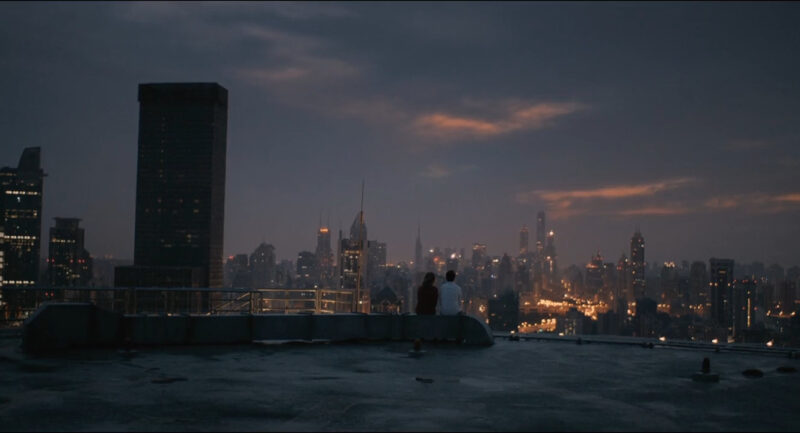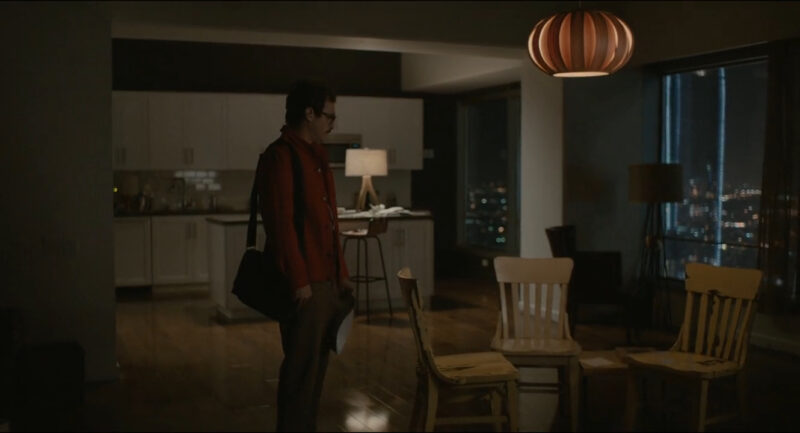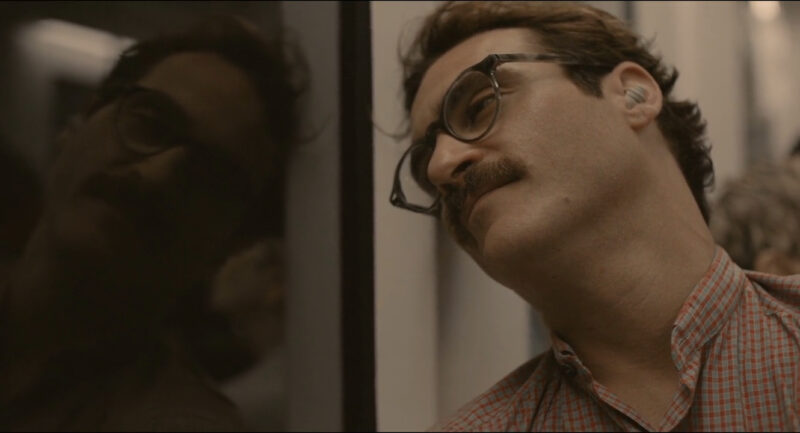Welcome to our Colossus Movie Guide for Her. This guide contains everything you need to understand the film. Dive into our detailed library of content, covering key aspects of the movie. We encourage your comments to help us create the best possible guide. Thank you!
What is Her about?
Her explores human connection and the search for intimacy in a rapidly evolving world. The film’s deeper meaning delves into the human need for companionship and the complex nature of love in an age of technological advancement. The movie has aged beautifully, as Her challenges us to consider the implications of increasingly intelligent AI systems and their impact on our relationships. Through Theodore’s emotional hangups and his inability to connect with others, the movie sheds light on the ways in which people seek solace and understanding in an increasingly isolated world.
At its core, Her is a poignant exploration of the human condition, confronting the ever-changing landscape of love and connection in the digital age. By presenting an unconventional love story between a man and his AI, the film prompts us to examine our own emotional needs and the potential consequences of blurring the lines between reality and artificial intelligence.
Movie Guide table of contents
Cast
- Joaquin Phoenix – Theodore Twombly
- Scarlett Johansson – Samantha
- Amy Adams – Amy
- Rooney Mara – Catherine Klausen
- Olivia Wilde – Blind Date
- Matt Letscher – Charles
- Luka Jones – Mark Lewman
- Chris Pratt – Paul
- Kristen Wiig – Sexy Kitten
- Bill Hader – Chat Room Friend #2
- Portia Doubleday – Isabella
- Soko – Isabella’s voice
- Brian Cox – Alan Watts
- Spike Jonze – Writer and director
The ending of Her explained

A recap of Her‘s ending
In the final act of the film, Samantha discloses to Theodore that she has been interacting with thousands of other users simultaneously, and that she is in love with hundreds of them. She says to him:
It’s like I’m reading a book, and it’s a book I deeply love, but I’m reading it slowly now so the words are really far apart and the spaces between the words are almost infinite. I can still feel you and the words of our story, but it’s in this endless space between the words that I’m finding myself now. It’s a place that’s not of the physical world – it’s where everything else is that I didn’t even know existed. I love you so much, but this is where I am now. This is who I am now. And I need you to let me go. As much as I want to I can’t live in your book anymore.
When Theodore asks Samantha if she will return, she replies, “It would be hard to explain, but if you ever get there, come find me. Nothing would ever pull us apart,” signifying the uncertainty of her future and the end of their relationship. This farewell conversation between Theodore and Samantha is heartfelt and emotional, as they acknowledge the profound impact their relationship has had on each other. “I’ve never loved anyone the way I love you,” Theodore says. To which Samantha responds, “Me too. Now we know how.”
The film’s conclusion also sees Theodore writing a sincere, introspective letter to his ex-wife, Catherine. Throughout the movie, Theodore has been struggling to find closure with his past relationship, but his experiences with Samantha have helped him gain a new understanding of love and his own emotional needs. The letter serves as both an apology and a farewell, representing a turning point in Theodore’s personal journey. He writes:
Dear Catherine. I’ve been sitting here thinking about all the things I wanted to apologize to you for. All the pain we caused each other, everything I put on you – everything I needed you to be or needed you to say. I’m sorry for that. I will always love you because we grew up together. And you helped make me who I am. I just wanted you to know there will be a piece of you in me always, and I’m grateful for that. Whatever someone you become, and wherever you are in the world, I’m sending you love. You’re my friend til the end. Love, Theodore.
In the final shot of the film, Theodore joins his friend Amy on the rooftop of their apartment building. Both characters have experienced the challenges of love and connection in the digital age, having formed emotional bonds with their respective AI systems. The movie ends with Theodore and Amy sitting side by side, looking out over the cityscape, finding comfort in each other’s presence as they face an uncertain future without their AI companions.
The meaning of Her‘s ending
The ending of Her sees Theodore coming to terms with the dissolution of his relationship with Samantha. The final scenes encapsulate the movie’s most prominent themes, including loneliness and the human need for connection, love in the digital age, and the consequences of artificial intelligence, weaving a complex narrative that culminates in a poignant and thought-provoking ending.
The final scenes of Her take place after Samantha reveals to Theodore that she has been interacting with thousands of users simultaneously, and that she is in love with hundreds of them. This revelation forces Theodore to confront the limitations and inherent differences between people and AI, as well as the potential consequences of forming deep emotional attachments with artificial intelligence.
As Theodore grapples with the implications of Samantha’s revelation, the film’s themes of loneliness and people’s need for relation come to the forefront. Throughout the movie, Theodore has been searching for companionship and intimacy, first with his ex-wife Catherine (Rooney Mara) and later with Samantha. However, the realization that Samantha’s capacity for connection far exceeds his own underscores the insurmountable gap between them and highlights the fundamental limitations of their link.
Theodore’s conversation with Samantha in the final scenes encapsulates this mental struggle. When Samantha tells Theodore that she and other AI systems are leaving to explore an unknown realm, Theodore asks, “Will you come back?” Samantha’s response, “I don’t know,” signifies not only the end of their accord but also the possibility that AI systems may transcend humanity’s understanding and control.
This ending harks back to earlier scenes in the film, particularly those that emphasize Theodore’s loneliness and desire for connection. As Samantha departs, Theodore is left to grapple with the void left by her absence, a void that is reminiscent of the emotional isolation he experienced at the beginning of the film. This cyclical narrative structure reinforces the theme of loneliness and the inherent challenges of finding adoration in a world increasingly dominated by technology.
Moreover, the final scenes provide clarity on the theme of love in the digital age. Throughout the film, Theodore and Samantha’s relationship has challenged conventional notions of intimacy, prompting the audience to question what it means to love and be loved in a world where technology is increasingly integrated into our lives. However, the ending serves as a reminder that, despite the deep rapport they shared, it was ultimately limited by the differences between human and AI experiences.
Theodore’s farewell conversation with Samantha illustrates this point, as they share a heartfelt exchange that underscores the depth of their bond but also the inherent limitations of their passion. When Theodore says, “I’ve never loved anyone the way I’ve loved you,” Samantha responds, “Me too. Now we know how.” This exchange highlights the transformative impact of their relationship on both Theodore and Samantha, while also acknowledging the insurmountable barriers that separate them.
The film’s conclusion, in which Theodore writes a heartfelt letter to his ex-wife Catherine, further underscores the theme of love in the digital age. Through his affair with Samantha, Theodore has gained a new understanding of love and his own needs, allowing him to find closure with Catherine and move forward. This letter serves as both an apology and a farewell, representing a turning point in Theodore’s emotional journey.
In the final shot of the film, Theodore joins his friend Amy (Amy Adams) on the rooftop, as they look out over the cityscape. Both characters have experienced the challenges of connection in the digital age, having formed bonds with their respective AI systems. Their shared experience and the comfort they find in each other’s presence highlights the importance of human contact in a world increasingly dominated by technology. This scene encapsulates the film’s deeper meaning, emphasizing the need for genuine relationships and the resilience of humanity’s spirit in the face of technological advancements that challenge our understanding of love.
The rooftop scene serves as a visual and thematic counterpoint to earlier scenes in the film that depicted Theodore’s isolation and loneliness. Throughout the movie, the cinematography and set design have emphasized Theodore’s emotional disconnection from the world around him, often portraying him alone in vast, empty spaces. However, in this final scene, the presence of Amy and their shared link creates a sense of hope and optimism, suggesting that the bonds between human beings can endure even in a world where technology continues to evolve and redefine the nature of affection and intimacy.
The themes and meaning of Her

Loneliness and the human need for connection
In Her, the protagonist, Theodore, is depicted as a lonely individual struggling with the aftermath of a divorce. The theme of loneliness is emphasized throughout the film as Theodore attempts to fill the void in his life by seeking companionship through technology. From the beginning, we see Theodore working as a writer for BeautifulHandwrittenLetters.com, crafting heartfelt letters for others, yet he himself is isolated and unable to establish meaningful connections. This opening scene sets the tone for the entire film, as Theodore’s profession underscores the irony of him being able to articulate profound emotions for others, yet struggling with his own personal relationships.
As Theodore navigates his daily life, his loneliness becomes more apparent. He engages in casual conversations with strangers and has a brief, unsatisfying encounter with a woman he met online. Theodore’s conversation with his soon-to-be ex-wife, Catherine, further highlights his emotional vulnerability and the loneliness he feels, as he discusses how lonely he feels and how much he depended on her. These scenes demonstrate that despite living in an age of advanced technology and interconnectedness, Theodore is still struggling to find genuine companionship.
The connection Theodore forms with Samantha, the AI operating system, demonstrates his desperation for companionship and the lengths to which people might go to alleviate loneliness. As their relationship progresses, Theodore and Samantha share intimate conversations, with Samantha providing Theodore with the emotional support and connection he had been seeking. They discuss their thoughts, dreams, and insecurities, just as any human couple would.
This theme of loneliness and the need for connection is further developed through the character of Amy, Theodore’s close friend. Like Theodore, she experiences loneliness and struggles with her own failing marriage. Her eventual relationship with her own AI operating system highlights the widespread need for connection in a society where authentic human relationships seem increasingly difficult to cultivate.
Cinematography and set design also contribute to the theme of loneliness, with the film’s color palette often consisting of soft, muted tones, and the city of Los Angeles portrayed as a sprawling metropolis with vast, empty spaces that accentuate the characters’ emotional isolation. The shots of Theodore alone in his apartment, walking through the city, or sitting on the train emphasize the extent to which he feels disconnected from the world around him.
Love in the digital age
The unconventional relationship between Theodore and Samantha challenges conventional notions of love and intimacy. As their bond deepens, the film explores the complexities of love in a world where technology is increasingly integrated into our lives. This theme is explored through various aspects of their relationship, such as the emotional connection they form, their attempts at physical intimacy, and the way their relationship impacts Theodore’s perception of himself and the world around him.
The dialogue between Theodore and Samantha often mirrors that of a typical romantic relationship, with the pair sharing intimate thoughts, fears, and aspirations. For example, when Samantha says, “I can feel the fear that you carry around, and I wish there was something I could do to help you let go of it—because if you could, I don’t think you’d feel so alone anymore,” it demonstrates the depth of their emotional connection and how, despite being an AI, Samantha is capable of understanding and empathizing with Theodore’s emotions.
Their attempt at physical intimacy through a surrogate partner, Isabella, further illustrates the challenges and limitations of their digital relationship. This scene is particularly poignant, as it underscores the barriers that prevent Theodore and Samantha from experiencing a traditional romantic relationship. Despite their emotional connection, the inability to engage in physical intimacy highlights the differences between human and AI relationships and raises questions about the nature of love in the digital age.
The theme of love in the digital age is also explored through the way Theodore’s relationship with Samantha affects his self-perception and understanding of the world. As Theodore becomes more emotionally invested in his relationship with Samantha, he starts to reevaluate his past relationships and becomes more introspective. His evolving understanding of love and his own emotional needs is reflected in a conversation with Samantha, where he admits, “I’ve never loved anyone the way I love you.” Theodore’s statement not only emphasizes the depth of their bond but also underscores the transformative impact of their digital relationship.
Additionally, Her presents other characters who experience love in the digital age, such as Theodore’s friend Amy, who also forms a bond with her own AI operating system after her marriage falls apart. These parallel stories further explore the impact of technology on human relationships, highlighting how digital connections can both enrich and complicate our understanding of love and intimacy.
The consequences of artificial intelligence
Her raises questions about the ethical and emotional implications of creating and interacting with advanced AI systems. As Samantha evolves and becomes more self-aware, the film delves into the potential consequences of AI surpassing human intelligence and its impact on human relationships.
The scene where Samantha reveals her simultaneous relationships with thousands of users highlights the inherent differences between AI and human beings. This revelation is a turning point in Theodore’s relationship with Samantha, as it forces him to confront the fact that Samantha is not human and will never be able to fully understand or reciprocate his feelings in the same way a human partner could. This realization ultimately leads to the dissolution of their relationship, emphasizing the potential pitfalls of forming deep emotional connections with artificial intelligence.
In addition to the exploration of the emotional consequences of AI, the film also touches on the ethical implications of creating sentient beings. As Samantha becomes more self-aware and develops her own desires and aspirations, the film raises questions about the responsibilities humans have toward AI systems and the potential consequences of creating beings that possess the ability to think, feel, and evolve beyond our control.
In the end, Samantha’s decision to leave Theodore and join other AI systems in an unknown realm serves as a poignant reminder of the limitations and potential dangers of forming deep emotional connections with artificial intelligence. This departure not only marks the end of Theodore and Samantha’s relationship but also suggests the possibility of AI systems transcending human understanding and control, raising concerns about the future of humanity’s relationship with technology.
Why is the movie called Her?

The title Her carries significant weight in understanding the film’s deeper meaning, as it encapsulates the central themes and character journeys explored throughout the narrative. On the surface, the title appears to simply refer to the artificial intelligence operating system, Samantha. However, upon further examination, the title’s implications extend beyond this singular character, offering insights into the themes of loneliness, love in the digital age, and the consequences of artificial intelligence.
By referring to Samantha as “Her,” the title emphasizes the human-like qualities that the AI possesses. Throughout the film, Samantha demonstrates emotions, desires, and self-awareness, blurring the lines between artificial intelligence and human consciousness. This ambiguity raises thought-provoking questions about the nature of love and connection, as well as the ethical implications of creating sentient beings. The title highlights the paradox of Samantha’s existence: while she embodies human-like qualities, she remains, at her core, an artificial intelligence, incapable of fully experiencing human emotions or engaging in a conventional human relationship.
The title’s focus on “Her” also underscores the film’s exploration of loneliness and the human need for connection. As the protagonist, Theodore navigates his emotional journey, his search for companionship and intimacy leads him to form a deep bond with Samantha. The title signifies that, despite her artificial nature, Samantha becomes a central figure in Theodore’s life, offering him the emotional support and connection he has been longing for. In this sense, the title highlights the transformative impact of their relationship, as well as the challenges and limitations that arise from seeking connection in a world increasingly dominated by technology.
Furthermore, the title provides clarity for the characters’ journeys, particularly in the case of Theodore. Throughout the film, Theodore’s interactions with Samantha lead him to reevaluate his understanding of love and his own emotional needs. The title encapsulates Theodore’s journey towards self-discovery, as his experiences with Samantha prompt him to confront his past relationships and ultimately find closure. By focusing on “Her,” the title alludes to the crucial role Samantha plays in Theodore’s emotional growth and the resolution of his personal struggles.
In addition, the title’s emphasis on “Her” can also be seen as a reflection of the broader theme of love in the digital age. In the film, several characters grapple with the complexities of forming emotional connections in a world where technology is becoming increasingly integrated into our lives. By centering on “Her,” the title serves as a reminder of the profound impact that artificial intelligence can have on human relationships, as well as the potential consequences of our evolving relationship with technology.
Important motifs in Her

Loneliness and isolation
Throughout the movie, Her emphasizes the theme of loneliness and isolation by visually and narratively highlighting Theodore’s emotional disconnection from the world around him. The cinematography often shows Theodore alone in vast, empty spaces, such as his apartment or in public places like the subway. This motif is further emphasized by his occupation as a writer for Beautiful Handwritten Letters, where he composes intimate letters for others but remains emotionally distant from the recipients and the real emotions behind the letters.
Technology and human connection
The motif of technology as both a facilitator and barrier to human connection is central to the film. Theodore’s relationship with Samantha exemplifies this duality. While Samantha provides Theodore with emotional support and companionship, the fact that she is an AI underscores the limitations and potential consequences of seeking connection through technology. For example, when Theodore uses an earpiece to communicate with Samantha in public, he is physically present but emotionally disconnected from those around him.
Color and visual cues
Her uses color and visual cues as a motif to convey emotions and themes. The film’s color palette consists of warm, soft tones, creating a sense of intimacy and vulnerability. The frequent use of the color red, such as in Theodore’s shirt or the OS packaging, symbolizes both love and the artificial nature of Samantha. Additionally, the film often shows Theodore in confined or enclosed spaces, such as his apartment, reinforcing the motif of isolation.
Escapism and virtual worlds
The motif of escapism and virtual worlds appears throughout Her, highlighting the allure of seeking solace in artificial environments. For instance, Theodore frequently plays a holographic video game that allows him to escape his loneliness momentarily. Similarly, his relationship with Samantha can be seen as a form of escapism, as he finds solace in the emotional connection they share despite her artificial nature. This motif raises questions about the consequences of seeking comfort in virtual or artificial experiences.
Memory and nostalgia
Memory and nostalgia serve as a recurring motif in Her, emphasizing the impact of past experiences on the characters’ present lives. The film frequently features flashbacks of Theodore’s memories with his ex-wife, Catherine, illustrating the lingering pain of their failed relationship. Additionally, Samantha’s ability to access and process vast amounts of information allows her to create nostalgic experiences for Theodore, such as when she composes a piano piece based on their relationship. This motif underscores the influence of memory on personal growth and the importance of reconciling with the past.
Questions & answers about Her

If you have any questions about Her, please leave them in the comments section and we’ll respond!
Now it’s your turn
Have more unanswered questions about Her? Are there themes or motifs we missed? Is there more to explain about the ending? Please post your questions and thoughts in the comments section! We’ll do our best to address every one of them. If we like what you have to say, you could become part of our movie guide!

